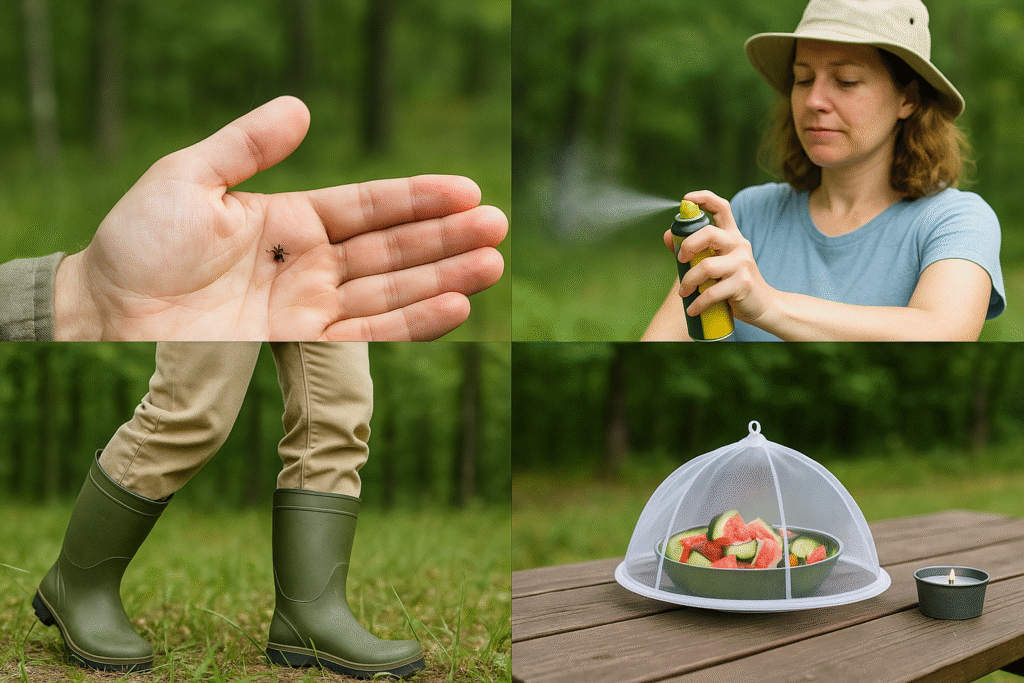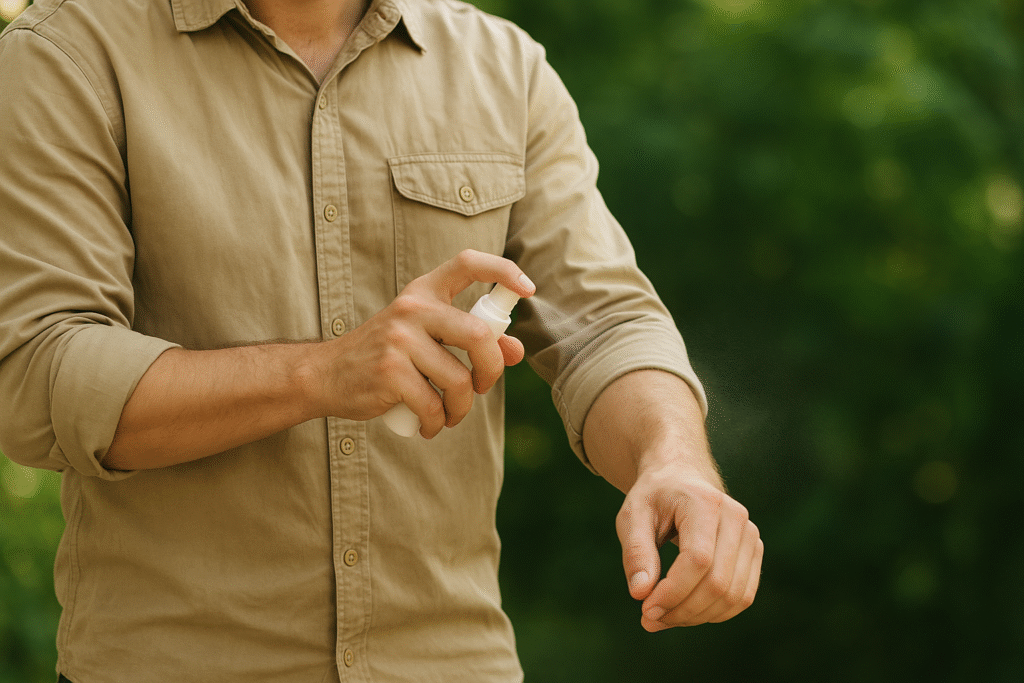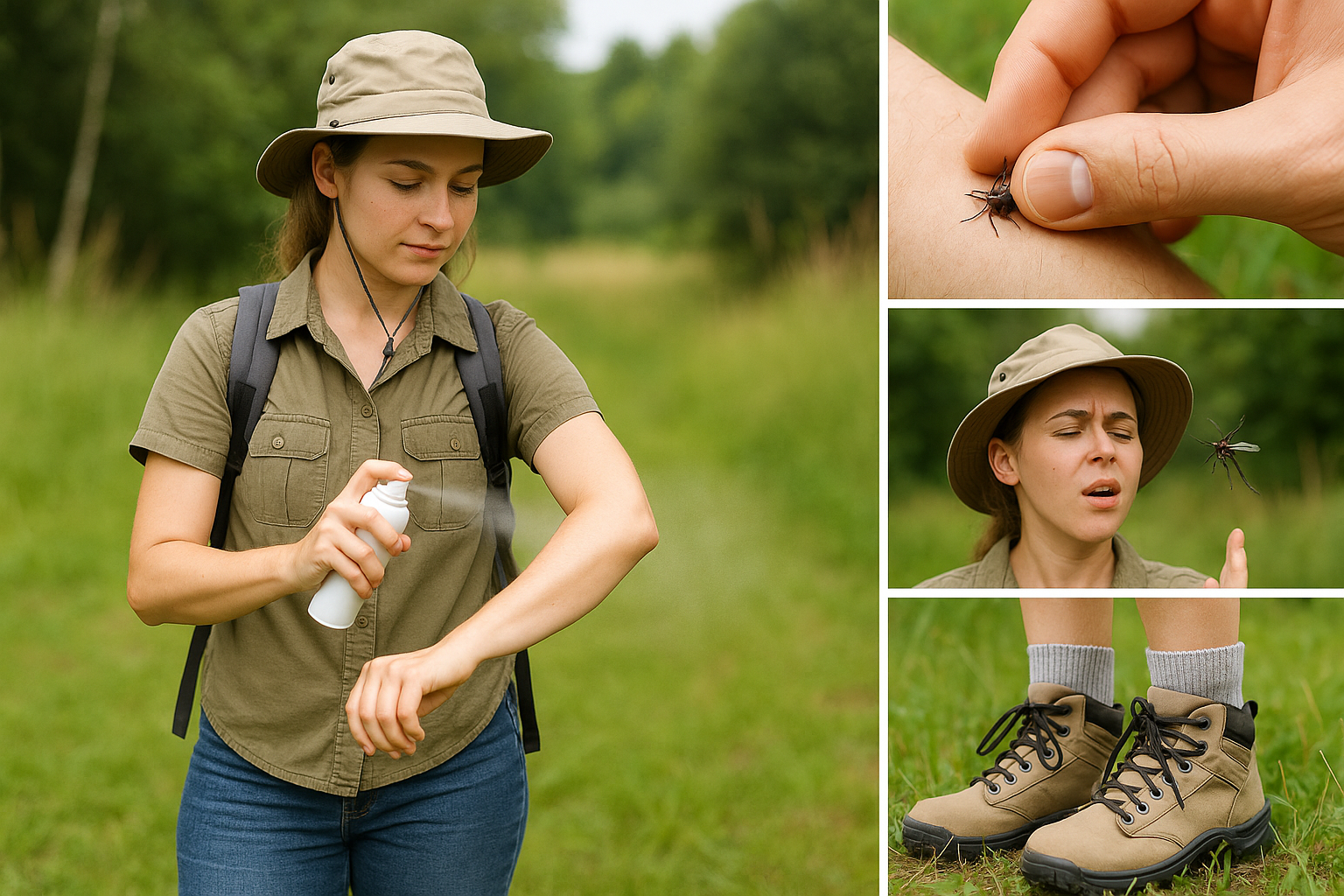Preventing Tick Bites: Tiny bites, big consequences. Mosquitoes and ticks transmit some of the world’s most important infections — from dengue, malaria and chikungunya to Lyme disease and babesiosis. This practical, evidence-based guide explains where the hotspots are, why risk is changing, and — most importantly — gives simple, realistic clothing-based defenses, natural and EPA-recommended repellents, yard & travel hacks, and a short interactive checklist you can use today.
Quick global snapshot (what the numbers say in 2024–2025)
- Vector-borne diseases remain huge worldwide. More than 3.9 billion people are at risk of dengue globally and WHO estimates tens of millions of symptomatic dengue infections each year. Dengue is rising fast in many regions. (World Health Organization)
- Malaria is still a major killer. The WHO estimated ~263 million malaria cases and roughly 597,000 malaria deaths in 2023, concentrated in the African Region. (World Health Organization)
- Tick-borne infections are increasing or expanding geographically in many countries. In the United States, tens of thousands of tick-borne disease cases are reported annually and CDC surveillance shows Lyme disease and other tick illnesses remain the most common vector-borne infections. (CDC)
- In the UK, public health agencies continue to caution about ticks and Lyme disease during outdoor months. UKHSA and NHS resources emphasise prevention, prompt removal, and awareness of local risk areas. (GOV.UK, nhs.uk)
Those are the big picture numbers — but what matters most for you is practical prevention. Read on.
Why vector risks are changing (short, plain explanation)
Several forces are increasing or shifting vector risk:
- Climate change (milder winters, longer warm seasons) allows mosquitoes and ticks to survive in new regions and increases their active season.
- Land use & urbanisation change habitats for hosts (rodents, deer, mosquitoes) and bring people closer to vector habitats.
- Global travel & trade move vectors and pathogens between regions.
- Gaps in surveillance & public health resources make early detection harder in some places.
Because risk is dynamic, local guidance matters — but layered personal protection always helps.
Mosquito vs. tick: different bugs, different threats — same prevention principle
- Mosquitoes feed briefly and may transmit viruses (dengue, Zika, chikungunya) and parasites (malaria). Many Aedes mosquitoes bite during the day; Anopheles at night.
- Ticks attach and feed for hours-to-days; many bacteria/parasites are transmitted only after prolonged attachment (often >24 hours). In the northern hemisphere, tick activity often peaks spring–autumn.
Shared prevention idea: reduce contact (barriers, repellents, clothing, environmental measures) and detect & remove (tick checks, mosquito netting, door/window screens).

Clothing-based defenses that actually work (for all climates)
Clothing is your first line of defense — especially on trails, in the garden, or while travelling.
1. Wear long, light-coloured clothing
Light colours make it easier to spot crawling ticks and mosquitoes. Long sleeves and long trousers reduce exposed skin. In hot climates, choose breathable fabrics (merino blends, lightweight synthetics).
2. Tuck trousers into socks and shirts into trousers
Tucking prevents ticks from reaching skin at the ankles or waist. This simple trick dramatically reduces tick-bite risk on trails and in tall grass.
3. Use permethrin-treated clothing (factory-treated or DIY kits)
Permethrin applied to clothing and gear (not directly to skin) repels and kills ticks and mosquitoes and remains effective after multiple washes if factory-treated. The EPA and CDC recommend permethrin-treated clothing for outdoor workers and travellers in high-risk settings. Use treated socks, gaiters, jackets, or spray treatments on boots and outer layers. (US EPA, CDC)
Safety note: Do not apply permethrin to the skin; follow product instructions and wash hands after applying.
4. Choose clothing with tight weaves and high collars
Tightly woven fabrics are harder for small mosquitoes to penetrate. Collars and cuffs reduce exposed entry points for ticks and mosquitoes.
5. Layering in hot climates
In hot, humid climates where long clothing can feel oppressive, use lightweight, loose long sleeves and breathable pants. Combine with a broad-spectrum repellent on exposed skin (see below).
Best insect repellents: what science and government agencies recommend
When searching for “what works,” rely on EPA/CDC-approved active ingredients. These are proven to reduce bites and disease risk.
- DEET (N,N-diethyl-m-toluamide): highly effective and long-lasting; safe when used as directed.
- Picaridin (icaridin): similar efficacy to DEET with low skin irritation; good for children and adults.
- IR3535 and oil of lemon eucalyptus (PMD): effective alternatives (note: oil of lemon eucalyptus is not recommended for very young children).
- Permethrin (for clothing): for treating clothing and gear, not skin. Factory-treated clothing is ideal; at-home sprays also available. (US EPA, Borough of Stanhope)
Practical repellent tips:
- Apply to exposed skin and/or clothing as per label instructions.
- Reapply after heavy sweating or swimming unless product claims waterproof protection.
- Don’t use repellents under clothing; avoid eye and mouth areas.
- For children, follow age-specific guidance on concentrations and safety. (US EPA)
Natural repellents — do they work?
Essential oils (citronella, lemongrass, peppermint) can provide short-term, mild protection but evaporate quickly and require frequent reapplication. For high-risk areas or travel to endemic zones (dengue, malaria, tick hotspots), rely on EPA/CDC-recommended products for reliable protection. Natural options are okay for low-risk local outings but aren’t a substitute for proven repellents when disease risk is present. (EWG, TIME)

Habitat & yard hacks: reduce vector populations around your home
Simple changes in your garden or yard reduce local mosquito and tick numbers:
- Mosquito control: remove standing water (plant pots, buckets, clogged gutters), maintain swimming pools, and use tight-fitting screens on windows and doors. Consider larvicide tips for persistent water bodies in consultation with local public-health guidance.
- Tick control: keep grass short, create a 3-foot gravel or woodchip buffer between lawns and wooded areas, discourage deer with fencing, and store woodpiles away from the house. Permethrin treatments (spot treatments for vegetation) and tick tubes for rodent control are used in some areas — consult local authorities before broad insecticide use. (World Health Organization, GOV.UK Assets)
Travel & seasonal tips (practical)
- Check local risk before travel. WHO, CDC travel notices and national public-health agencies publish up-to-date outbreak info (dengue, chikungunya, malaria). (World Health Organization)
- Night-time protection for malaria risk areas: use insecticide-treated bed nets (ITNs) and indoor residual spraying where recommended; take antimalarial prophylaxis when advised by a clinician.
- Daytime prevention for Aedes viruses (dengue, chikungunya): Aedes mosquitoes bite during the day — wear repellent and protective clothing during daytime, especially early morning and late afternoon. (World Health Organization)
How to do tick checks and remove ticks safely (step-by-step)
Tick checks are quick and lifesaving. Ticks often attach near warm, hidden skin folds (groin, armpits, scalp). Do a full-body check after outdoor activities and follow these removal steps:
- Use fine-tipped tweezers.
- Grasp the tick as close to the skin as possible and pull upward with steady, even pressure — don’t twist or jerk.
- After removal, clean the bite site with soap and water, antiseptic, or alcohol.
- Save the tick (in a sealed container) if local health services offer testing. Note date and location of bite.
- Watch for early signs of disease (rash, fever, flu-like symptoms) for several weeks; seek medical care if symptoms appear. (GOV.UK Assets, nhs.uk)
Do not use home remedies (petroleum jelly, hot matches) — these can increase tick salivation and pathogen transmission.
Special populations & pets
- Children: use lower-concentration repellents per label and dress children in treated clothing where appropriate. Supervise application.
- Pets: follow veterinary guidance for tick and mosquito prevention products; pets can bring ticks into the home. Check pets after walks and use vet-recommended tick collars or spot-on treatments.
- People with allergies or chronic illness: consult a clinician before travel to endemic areas and seek tailored advice on prophylaxis, vaccines (where available), and treatments.
Interactive checklist: Are you ready to reduce your personal risk?
Answer YES/NO and follow the suggested action.
- Do you wear long, light-coloured clothing and tuck trousers into socks in grassy/wooded areas?
- If NO → start today: tuck and cover; consider permethrin-treated socks.
- Do you carry and correctly apply an EPA/CDC-recommended repellent when outdoors?
- If NO → pick a DEET or picaridin product and follow label instructions.
- Do you perform tick checks after outdoor activities and know how to remove ticks safely?
- If NO → practice a tick check routine and keep fine-tipped tweezers handy.
- Do you reduce standing water at home and maintain screens on windows/doors?
- If NO → remove containers with standing water and repair screens.
- Are you up to date with vaccines and local travel health advice when visiting vector hotspots?
- If NO → consult a travel or primary care clinic before travel.
Complete at least three “YES” actions this week and you’ll materially reduce bite risk.
When to seek medical care
- Tick bites: see a clinician if you develop a rash (especially a bull’s-eye rash), fever, flu-like illness, or neurologic symptoms after a bite. Early antibiotic treatment for Lyme disease is effective.
- Mosquito-borne illness: seek care for fever after travel to endemic areas, especially if rash, severe headache, eye pain, or bleeding occurs. Health authorities advise urgent evaluation for suspected dengue complications. (nhs.uk, World Health Organization)
Resources — government & authoritative links (click to open)
- WHO — Vector-borne diseases (global overviews): https://www.who.int/news-room/fact-sheets/detail/vector-borne-diseases. (World Health Organization)
- WHO — Dengue situation updates: https://www.who.int/emergencies/disease-outbreak-news. (World Health Organization)
- World Malaria Report 2024 (WHO): https://www.who.int/teams/global-malaria-programme/reports/world-malaria-report-2024. (World Health Organization)
- CDC — Preventing mosquito bites (repellents, treated clothing): https://www.cdc.gov/mosquitoes/prevention/index.html. (CDC)
- CDC — Lyme disease & tick data (US surveillance & maps): https://www.cdc.gov/lyme/data-research/facts-stats/index.html. (CDC)
- EPA — Repellent-treated clothing & repellent safety information: https://www.epa.gov/insect-repellents/repellent-treated-clothing and https://www.epa.gov/insect-repellents/using-insect-repellents-safely-and-effectively. (US EPA)
- NHS / NHS Inform — Tick bites, Lyme disease & bite advice (UK): https://www.nhs.uk/conditions/lyme-disease/ and https://www.nhsinform.scot/illnesses-and-conditions/injuries/skin-injuries/tick-bites/. (nhs.uk, NHS inform)
Final takeaway — a layered approach wins
Preventing tick bites and reducing mosquito contact are achievable with a layered strategy: smart clothing choices (permethrin-treated when appropriate), reliable repellents, habitat control, quick tick checks, and good travel/seasonal planning. These steps lower your odds of infection and let you enjoy the outdoors safely.
Disclaimer
This article is informational and not a substitute for medical advice. For personal medical questions, diagnosis, or treatment, consult a qualified healthcare professional. The public-health links above point to authoritative government agencies (WHO, CDC, EPA, NHS) and were valid at the time of publication. All images used in this article are royalty‑free or licensed for commercial use and are provided here for illustrative purposes.
